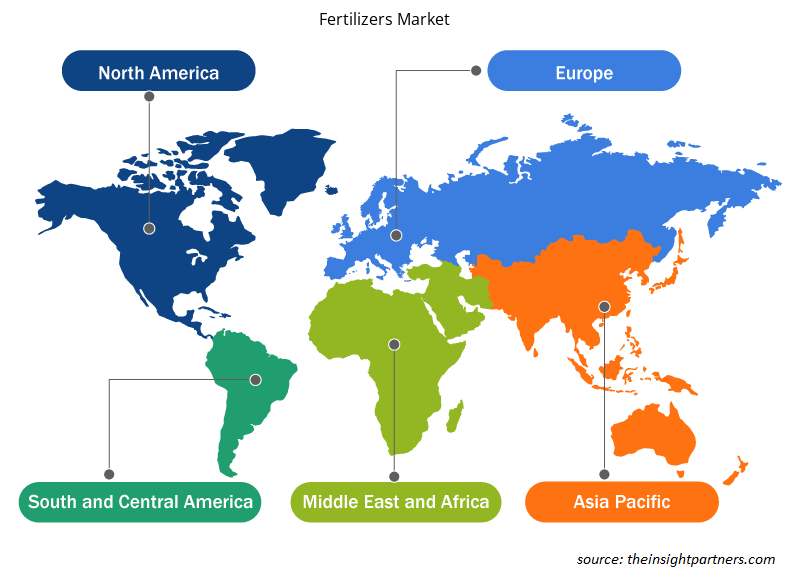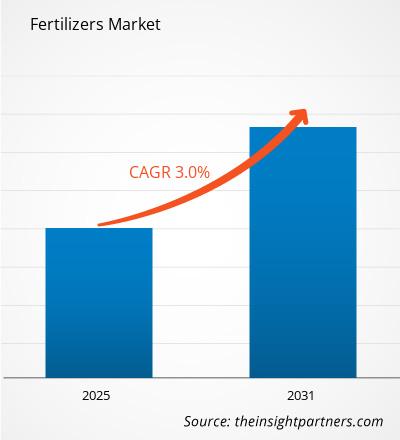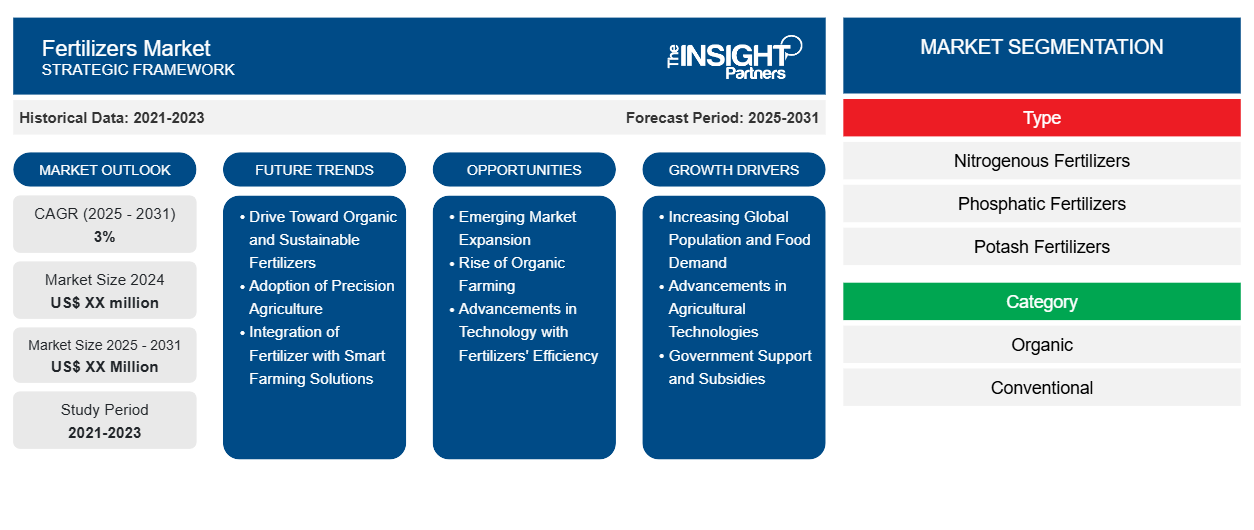预计肥料市场在 2024 年至 2031 年期间的复合年增长率为 3%,市场规模将从 2024 年的 XX 百万美元扩大到 2031 年的 XX 百万美元。
肥料市场涵盖按类型(氮肥、磷肥、钾肥、微量元素肥料等)、类别(有机和常规)、形式(液体、干燥和颗粒)、作物类型(谷物和谷物、油籽和豆类、水果和蔬菜等)和地理区域(北美、欧洲、亚太地区、中东和非洲以及南美和中美洲)进行的分析。农业生产者和农民通常使用肥料来提高作物产量并增强每种作物的整体健康状况。他们将肥料添加到土壤中,土壤是植物必需营养的主要来源。
报告目的
The Insight Partners 撰写的《化肥市场》报告旨在描述当前形势和未来增长、主要驱动因素、挑战和机遇。这将为各种业务利益相关者提供见解,例如:
- 技术提供商/制造商:了解不断变化的市场动态并了解潜在的增长机会,从而能够做出明智的战略决策。
- 投资者:对市场增长率、市场财务预测以及整个价值链中存在的机会进行全面的趋势分析。
- 监管机构:监管市场政策和警察活动,旨在最大限度地减少滥用行为,维护投资者的信任和信心,维护市场的完整性和稳定性。
肥料市场细分
类型
- 氮肥
- 磷肥
- 钾肥
- 微量元素肥料
类别
- 有机的
- 传统的
形式
- 液体
- 干燥
- 粒状
作物类型
- 谷物和谷类
- 油籽和豆类
- 水果和蔬菜
定制此报告以满足您的需求
您可以免费定制任何报告,包括本报告的部分内容、国家级分析、Excel 数据包,以及为初创企业和大学提供优惠和折扣
-
获取此报告的关键市场趋势。这个免费样品将包括数据分析,从市场趋势到估计和预测。
肥料市场增长动力
- 全球人口和粮食需求不断增长:随着全球人口的膨胀,粮食生产的需求也随之增加。鉴于不断增长的人口对粮食的需求不断增加,肥料在提高农作物产量以及农业粮食安全方面的作用已得到广泛认可。
- 农业技术的进步:精准农业等现代农业技术也刺激了对肥料的需求。这些技术的最大利用率、营养输送的优化和废物的减少鼓励农民采用创新肥料来提高产量和可持续性。
- 政府支持和补贴:各国政府大多通过实施不同的补贴和激励措施来鼓励使用化肥,以促进农业发展。这些政策将增加农作物产量,改善粮食安全,发展农村经济,从而提升发达市场和发展中市场对化肥的需求。
肥料市场未来趋势
- 推动有机和可持续肥料:随着对环境影响的认识不断提高,对有机肥料的需求也随之改变,因为农民正在寻求更环保的解决方案来最大限度地减少化学品的使用,改善土壤健康,并且他们考虑消费者在有机农产品中的饮食习惯来支持有机肥料市场。
- 采用精准农业:当今的肥料市场由精准农业定义。土壤传感器、GPS、数据分析等的使用确实能够从少量肥料中获得更多收益,因为它们与更好的直接注入能力相结合,甚至可以减少浪费并提高生产力。这推动了缓释肥料和定制肥料的新需求。
- 肥料与智能农业解决方案的整合:肥料越来越多地与智能农业技术相结合,例如无人机辅助施用和基于物联网的监控。这些技术使农民能够根据可用的实时数据优化肥料使用,提高作物产量,同时将对环境的不利影响降至最低,同时提高肥料的有效性,确保未来市场的增长。
肥料市场机会
- 新兴市场扩张:随着农业向另一个层次转型,新兴经济体的肥料生产空间巨大。这些市场,尤其是亚洲、非洲和拉丁美洲的市场,确实蕴藏着巨大的增长机会。农民希望采用这些肥料来提高农作物产量,同时满足日益增长的粮食需求。
- 有机农业的兴起:随着有机食品在市场上越来越受欢迎,有机肥料的需求也越来越大,有机肥料的机会也越来越大。随着消费者的健康和环保意识逐渐增强,天然肥料的市场正在不断扩大,天然肥料可以提高土壤肥力,并采用有机农业的最佳实践,为制造商提供增长潜力。
- 肥料效率技术进步:未来的先进肥料,包括缓释或控释型肥料,为精准农业提供了可能性。减少营养浪费、提高效率和维持绿色农业实践是这些产品可能带来的一些好处。随着世界朝着更好、更高效和更环保的解决方案迈进,这似乎是该行业的一个重要增长机会。
肥料市场区域洞察
Insight Partners 的分析师已详尽解释了预测期内影响化肥市场的区域趋势和因素。本节还讨论了北美、欧洲、亚太地区、中东和非洲以及南美和中美洲的化肥市场细分和地理位置。

- 获取肥料市场的区域特定数据
肥料市场报告范围
| 报告属性 | 细节 |
|---|---|
| 2024 年的市场规模 | XX 百万美元 |
| 2031 年市场规模 | XX 百万美元 |
| 全球复合年增长率(2025 - 2031) | 3% |
| 史料 | 2021-2023 |
| 预测期 | 2025-2031 |
| 涵盖的领域 |
按类型
|
| 覆盖地区和国家 |
北美
|
| 市场领导者和主要公司简介 |
|
肥料市场参与者密度:了解其对业务动态的影响
肥料市场正在快速增长,这得益于终端用户需求的不断增长,而这些需求又源于消费者偏好的不断变化、技术进步以及对产品优势的认识不断提高等因素。随着需求的增加,企业正在扩大其产品范围,进行创新以满足消费者的需求,并利用新兴趋势,从而进一步推动市场增长。
市场参与者密度是指在特定市场或行业内运营的企业或公司的分布情况。它表明在给定市场空间中,相对于其规模或总市场价值,有多少竞争对手(市场参与者)存在。
在肥料市场运营的主要公司有:
- 凯里集团有限公司,
- 塔拉坎公司
- ADM,
- 协同作用
- 口味公司,
免责声明:上面列出的公司没有按照任何特定顺序排列。

- 了解肥料市场的主要参与者概况
主要卖点
- 全面覆盖:报告全面涵盖了肥料市场的产品、服务、类型和最终用户的分析,提供了整体概况。
- 专家分析:报告基于对行业专家和分析师的深入了解而编写。
- 最新信息:该报告涵盖了最新信息和数据趋势,确保了其与业务的相关性。
- 定制选项:此报告可以定制以满足特定客户要求并恰当地适应业务策略。
因此,肥料市场研究报告有助于引领解读和了解行业情景和增长前景。尽管可能存在一些合理的担忧,但本报告的总体优势往往大于劣势。
- 历史分析(2 年)、基准年、预测(7 年)及复合年增长率
- PEST和SWOT分析
- 市场规模、价值/数量 - 全球、区域、国家
- 行业和竞争格局
- Excel 数据集
近期报告
客户评价
购买理由
- 明智的决策
- 了解市场动态
- 竞争分析
- 客户洞察
- 市场预测
- 风险规避
- 战略规划
- 投资论证
- 识别新兴市场
- 优化营销策略
- 提升运营效率
- 顺应监管趋势























 获取免费样品 - 肥料市场
获取免费样品 - 肥料市场